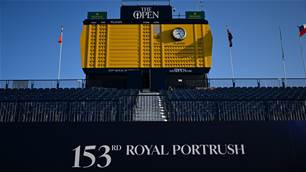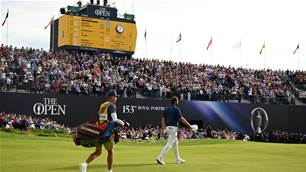Sixty-two years ago this month, Kel Nagle stunned the golfing world when he held off a final round charge from Arnold Palmer to win the Centenary Open Championship at St. Andrews.
The then 39-year-old had stared down the biggest name in the game to win the world’s oldest championship at the spiritual home of golf and mark the greatest achievement of his long, illustrious career.
Despite his almost veteran status, Nagle had only ever played the Open Championship twice before 1960.
His first was in 1952 at Lytham and St Annes and then in 1955 when Peter Thomson won at St. Andrews and he finished 11 shots behind.
In an interview with Golf Australia magazine years later, Nagle confessed playing the Old Course “gave me goose bumps” because of his relative unfamiliarity with such a grand stage. And then there was the unrivalled atmosphere that the Open Championship attracts, especially at St. Andrews, and all the surrounding history.
Nagle was fairly offhanded about his chances, as were the bookies, who installed him at 100-1 on the eve of the tournament. Thomson, his long-time Canada Cup matches team mate and life-time friend, had a very different view.
A month before the Open, Nagle found a new McGregor driver after searching through box after box of clubs in a warehouse in Fort Worth, Texas.

Some years earlier, after studying the top Americans on his first trip to Britain, he had transformed his game, reducing to a three-quarter backswing and thus sacrificing distance for accuracy. He also shortened his putting stroke, yet with the light Bullseye putter he had picked up from a warehouse in 1954 in Chicago, he was already an envied magician on the greens. And he relentlessly practiced his short game, working assiduously with his 6, 7, 8, 9, wedge and sand iron and would spend countless hours playing bunker shots.
So armed with his potent new driver, he and Thomson headed to Britain, where they finished third in the Canada Cup at Portmarnock in Ireland behind the Americans, Arnold Palmer and Sam Snead, and England’s Bernhard Hunt and Harry Weetman. After that, Thomson genuinely believed Nagle was playing well enough to win the Open.
“He said to me ‘geez, Kel, you’re playing well … you’re driving well, you’re putting
well and your irons are good. I know St. Andrews inside out and I really think you can win the Open there,” Nagle would later recall.
“I had played well in Ireland, but wasn’t so sure. He was right though. Peter was a good judge of form and I wish I had listened more closely. I was 100-1 at the bookmakers but didn’t have a bet.
“So, we practiced around the Old Course and in the championship, I played with my new driver and also a new set of irons … and that’s how it all happened.”
“Then on the last hole, where I needed a four to win, I hit my 9-iron approach to about four feet and two-putted for my par and a one-shot victory … and that’s how it all happened.” – Kel Nagle.
In those days, the tournament configuration was somewhat different. The first round of the Open was played on Wednesday, round two on Thursday, with the final two rounds contested on Friday. But with the last round disrupted by rain in what even the British thought was an extremely wet summer, the final round was postponed until Saturday.
Nagle opened with a 69 in the first round, after holing what he later described as “a monster from underneath the green on the 17th” for three. He then went two better with 67 the next day to trail Argentina’s Roberto de Vicenzo by two strokes.
On the final day, Nagle had a 71 in the morning and de Vicenzo was four shots worse before the Heavens opened, turning the 18th green’s infamous Valley of Sin into a swimming pool, while the steps leading from the R&A clubhouse down to the course were awash with gushing water. It led to the postponement of the last round and the field returned for the final round on Saturday.
As the championship began drawing to a close, Nagle was edging towards victory, although Palmer, in the group directly in front of him, loomed as the man to beat.
“I was pretty comfortable with about four holes to go,” Nagle recounted in an interview with John Huggan for this magazine years later. “But on the 15th, I three-putted and Arnold had made birdie three there. Then I watched him get four off the road on the 17th, the notorious Road Hole, and finally he was looking at a birdie putt on the last of about 12-14 feet.
“There I was standing on the 17th green needing an awkward eight-footer to make my four and stay ahead of him. I decided to wait a while until Arnold holed out to see just what I had to do.
“He holed his birdie putt – I only knew from the massive crowd noise up ahead – for a closing 68.”

Nagle – under immense pressure and with thousands of spectators closing in – needed to finish with two pars for the victory of a lifetime.
“Lo and behold, I holed that eight-footer. It was probably one of the best putts I’ve hit in my life. It had a right-to-left borrow and never looked like missing,” Nagle recalled.
“Then on the last hole, where I needed a four to win, I hit my 9-iron approach to about four feet and two-putted for my par and a one-shot victory … and that’s how it all happened.”
Thomson was the first person onto the 18th green to congratulate him.

With the presentation ceremony about to commence, he realised he did not have a jacket as he hadn’t been thinking about prizes when he left for the course. So, Thomson loaned him his and Nagle took to the clubhouse steps wearing the former champion’s grey tweed sports coat.
“When you think of it,” Nagle would laugh, “I took Peter’s trophy (he had won it four times before) as well as his jacket.”
Thomson, writing in his column for The Age and Sydney Morning Herald newspapers the following day, called Nagle the “king of putters.”
“His long game and approaching were as good as anyone else’s,” Thomson wrote. “But it was his magnificent, sure putting that won in the end.
Thomson continued: “The American Arnold Palmer, who finished second, fought like a man who has experienced opponents crashing in front of him.
“But this time he found one that didn’t.
“I couldn’t be happier had I won the Open myself.”
For his historic victory, Nagle received a cheque for £1,120, as well as a replica of the Claret Jug and his Open medal.
“That more than covered the trip from Australia, but there wasn’t much left over,” he said. “Then I developed tendonitis in my right little finger immediately afterwards. It would curl up overnight and left me able to hit only a few shots. So, I didn’t play for my first three months as Open champion.
“That cost me a lot of money. I couldn’t play any exhibition matches, which was where we made most of our cash in those days.”
 Nagle’s tournament playing career spanned almost three decades and he won at least one tournament every year from 1949 to 1975. He won the Open championships of France, Britain, Canada, Australia, New Zealand (seven times), Hong Kong and Switzerland. He also won six Australian PGAs and seven New Zealand PGAs, as well as a further 17 times around the world.
Nagle’s tournament playing career spanned almost three decades and he won at least one tournament every year from 1949 to 1975. He won the Open championships of France, Britain, Canada, Australia, New Zealand (seven times), Hong Kong and Switzerland. He also won six Australian PGAs and seven New Zealand PGAs, as well as a further 17 times around the world.
RIGHT: Kel Nagle with the Claret Jug, his replica and Peter Thomson's jacket. PHOTO: Getty Images.
There were also the celebrated victories alongside his good mate ‘Thommo’. The pair won the Canada Cup (now the World Cup) in Montreal in 1954 and again in front of the home crowds at Royal Melbourne in 1959, when Sam Snead observed: “Kel never hit one bad putt. I’ve never seen putting like that in my life.”
‘The Pymble Crusher’ as some would call him, almost added a second major to his resume at the 1965 U.S Open at Bellerive, where he tied Gary Player after 72 holes before losing the 18-hole playoff 71-74.
But it will his Centenary Open victory over the then new wonder boy of world golf that he will always be remembered for, perhaps even more so at The 150th Open Championship when it returns to St. Andrews this month.
As for Palmer, he returned to The Open Championship the following year at Royal Birkdale and claimed his first of two Claret Jugs in consecutive years.
When Palmer successfully defended his Open title, at Troon, in 1962, he finished six strokes clear of his nearest rival … Nagle, the only other player in the field to finish under par for the tournament.
Palmer’s devotion to playing The Open changed the way the United States saw the game’s oldest championship and an increasing number of American players began annually crossing the Atlantic, out of their comfort zone, to try and capture the title.
Related Articles

The Aussies at The Open

The Open Preview: Back Again













